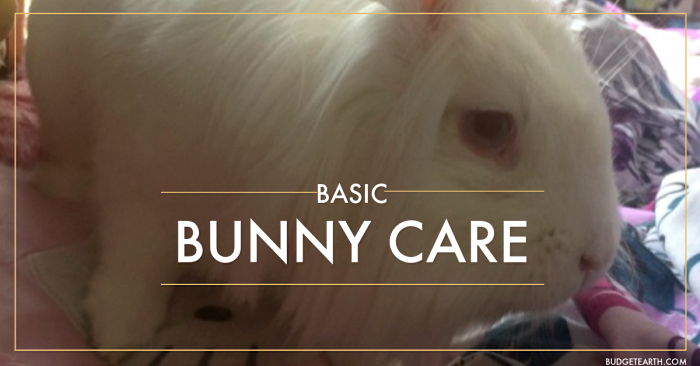

So you’ve done your research, decided that a rabbit is right for you, and you’re ready to take on the challenge of rabbit parenthood. Although I’ve already discussed the basics of feeding, there’s still a lot to learn about these cute and funny little creatures! While they’re very easy to love, they’re not always as easy to care for. Rabbits have a life span of 10+ years and many specific care requirements. As I’ve mentioned in previous articles, I strongly suggest you do your own additional research, but let’s talk about the basics of bunny care to help get you started!
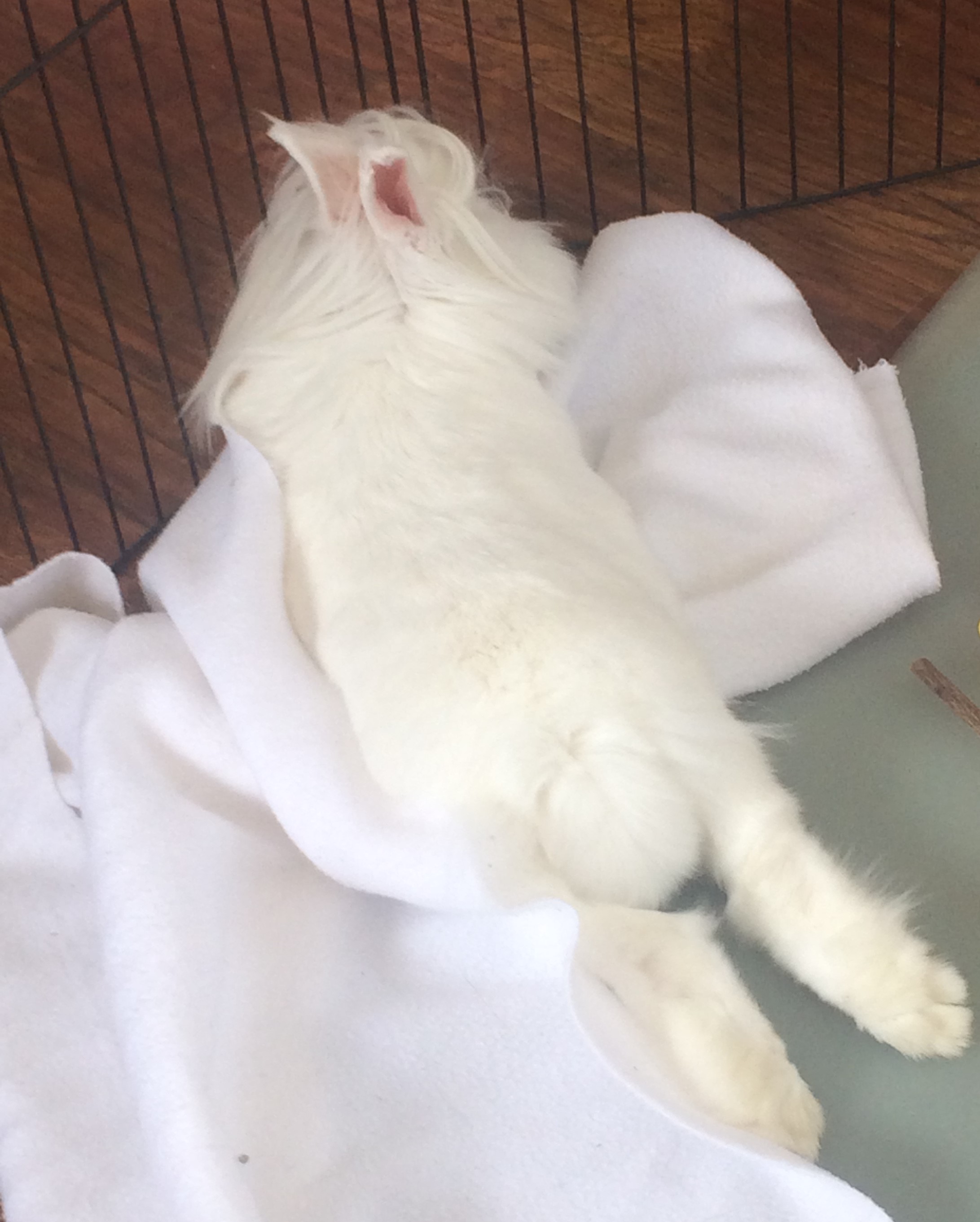 Sometimes you just wanna relax and kick out your snowshoes.
Sometimes you just wanna relax and kick out your snowshoes.
Basic Bunny Care: Housing
The safest place for your bun to live is indoors. Domestic rabbits do not tolerate extreme temperatures well, especially during the hot months of summer, and I’ve spoken with many first-time rabbit owners who lost their bunnies because of their lack of knowledge of this. A rabbit’s habitat should never be in direct sunlight or in a drafty area, and average household temperatures for your bun shouldn’t exceed 80°F.
In addition to temperature concerns, predators are another risk. The sight or sound of a nearby wild animal (or even just an unleashed neighborhood dog) can exert enough stress on a rabbit to cause a heart attack. Other potential concerns for outdoor rabbits are fleas, ticks, and fly maggot infestations in their stool.
Whether you choose to cage your rabbit or allow it to freely roam, it’s important to bunny proof the area the rabbit lives in. Electrical cords should be stored out of reach and outlets need to be covered. Rabbits love and need to constantly chew due to their ever-growing teeth, and if they treat a plugged-in cord as a chew toy it can be fatal. Given their curiosity and love of chewing, ensure that not only obvious poisons (like insect- or rodenticides and cleaning supplies) but also common house plants (like aloe) aren’t left in the open or in unlocked low cabinets.
Rabbits do not cope well with slick and slippery surfaces like hardwood floors (they have no pads on their feet for traction!), and they often like to chew carpet (bad for both your house and bun, as it can cause intestinal blockages). Some flooring ideas of what you might use instead are towels, cotton throw rugs, sea grass mats, or plywood covered with linoleum. Because the playpen area of Biscotti’s housing is on top of hardwood floor, I covered most of it with a hard surface chair mat I had on hand and then switch between using clean towels and soft fleece for the rest of it.
If your rabbit does not have run of the house or even just a room, it’s recommended that the cage be at least five times the size of the rabbit. Buns need space to relax, completely stretch out, and stand up on their hind legs to scope out the area (or beg for treats), so in addition to width and length don’t forget to consider height. Nobunny wants to bump their head on top of the cage, and of course you don’t want anybunny hopping OUT of their cage!
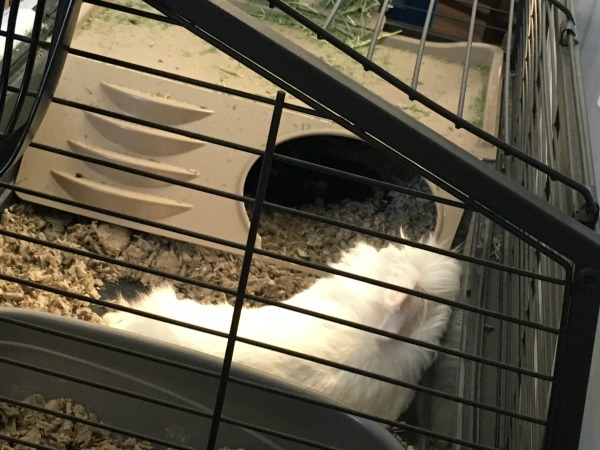 Please don’t bother me when it’s bunny bedtime…
Please don’t bother me when it’s bunny bedtime…
If you buy a cage with wire flooring, you can avoid sore hocks and other problems by layering the floor with cardboard or another material. Rabbit feet don’t have protective pads like those of dogs and cats, so be considerate of your bunny’s feet! Biscotti’s former owners were kind enough to give me this cage with him, and I was pleased to see that they had covered the wire door ramp with a soft fabric material. If your bun’s space doesn’t come with a hidey hole you can easily give him or her a cardboard box with a couple of entrances cut into it to use as a comfortable hiding spot. Biscotti also has a pet bed that he loves to hide in! These covered spaces offer a place to relax and for the rabbit to feel safe, and are also fun for bun to explore. Remember to respect your rabbit’s need for quiet time, as rabbits are often playful at dawn and dusk and tend to sleep during the day.
Basic Bunny Care: Potty Training
A lot of new rabbit owners are surprised to learn that bunnies can be litterbox trained, just like a cat! Rabbits usually have a particular corner in their habitat they like to use as their bathroom, so all you need to do is take note of that spot and simply add a litter pan there to encourage the behavior. If your rabbit has free roam of more than one room in your house, station litter pans in several places. Be aware that it’s normal to see a few pieces of poo scattered as a territorial warning that the area belongs to them.
Most rabbits enjoy spending time in their litterbox, and also like to snack while they potty, so be sure to select a litterbox of ample size and consider placing the rabbit’s hay rack above the litter pan. You may also wish to line the litterbox with hay. For Biscotti, I like to use whatever is leftover in his hay rack from the day before so that I’m not constantly adding new hay on top of old hay that will never be eaten.
When selecting litter to use in the box, avoid buying corn cob, clumping or dusty cat litters as they can cause serious health issues if eaten. Also avoid the commonly sold pine, cedar or other wood shavings in pet stores because they may cause liver damage or trigger allergic reactions in your rabbit. Do select organic litters made of paper, wood pulp, or citrus. Newspaper is also acceptable but does not absorb as well. Clean litterboxes daily.
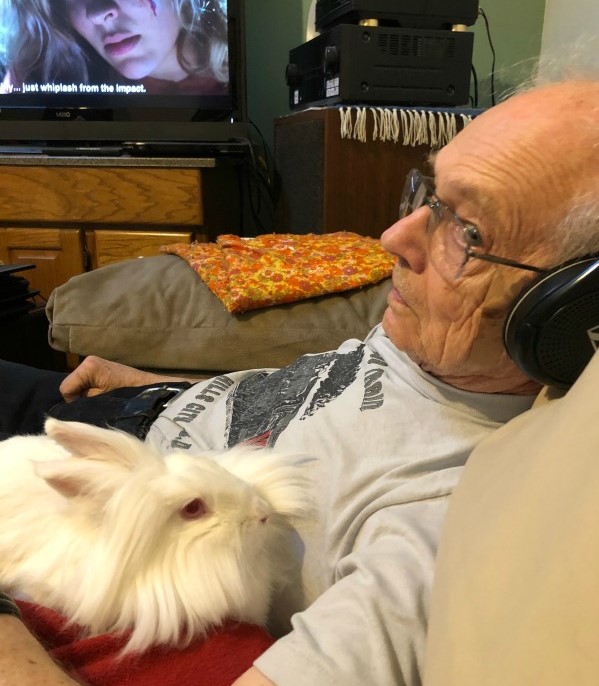 Let’s hang out! You bring the snacks.
Let’s hang out! You bring the snacks.
Basic Bunny Care: Handling and Socialization
While bunnies are very social and thrive on attention, they are also fragile and need careful handling. Allow your bun to grow accustomed to being handled slowly. When working with your new friend, speak calmly and pet the bunny gently between the eyes, until it relaxes, before attempting to pick it up. You never want to try to lift a struggling rabbit because it can injure either itself or you. Pick up the bun by placing one hand underneath the front of the rabbit and the other hand beneath its back side, lifting carefully with both hands and bringing the bun against your body. A rabbit’s body should never hang free or be lifted by the stomach or ears. When holding a rabbit, always fully support its body – especially the hind legs.
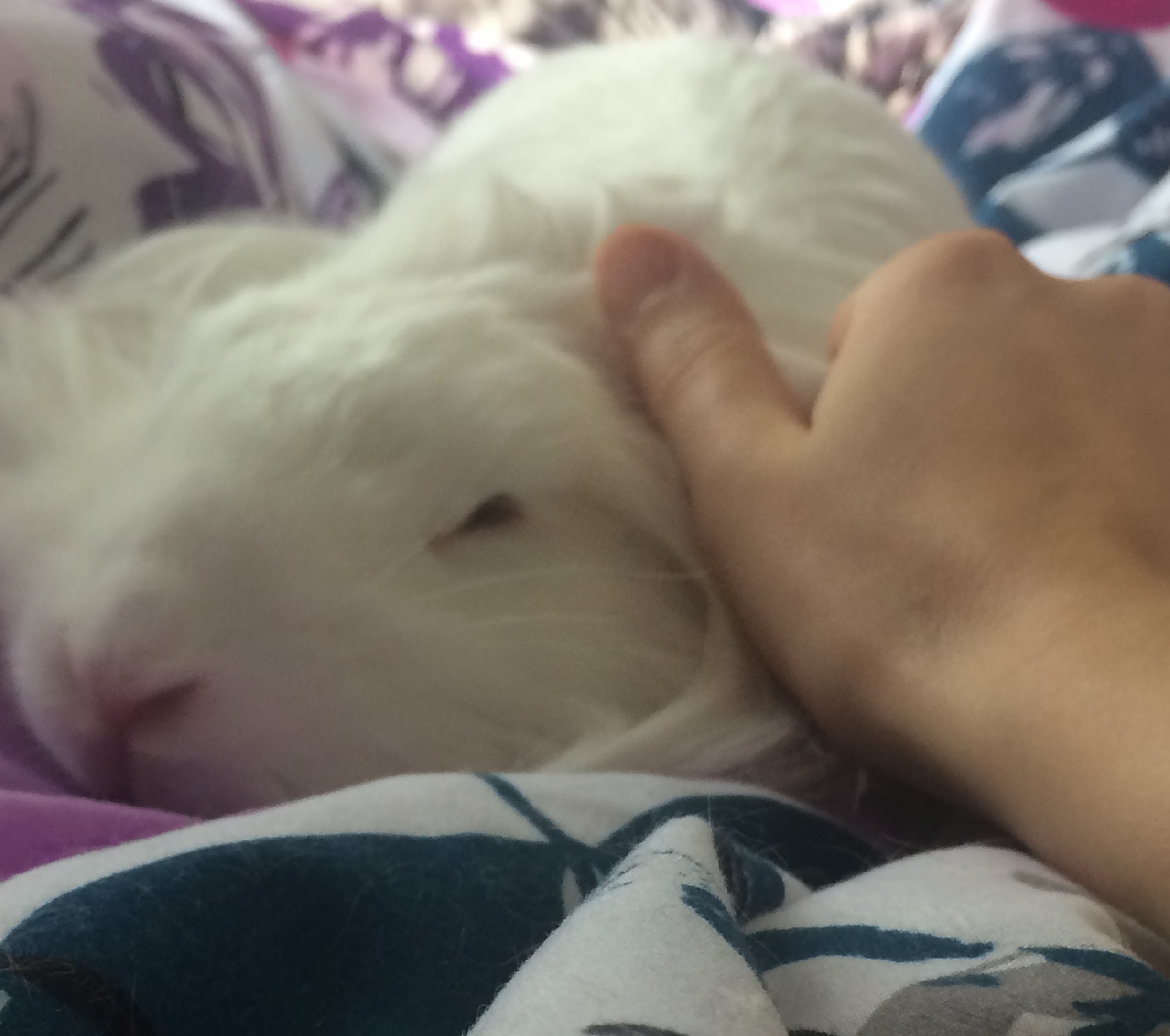 Biscotti loves being petted and flattens out into a little bunny pancake.
Biscotti loves being petted and flattens out into a little bunny pancake.
Rabbits love attention and a great way to bond with your bun is to “groom” one another. If possible, talk to your bun calmly and stroke him or her daily. Allow your rabbit to familiarize itself and bond with you by petting it on top of its head, down its back, and around and between the eyes, ears, and top of the nose. These are the areas rabbits typically groom one another. Just be aware that, if your rabbit is not used to being touched, it may flinch or startle at first. Also of note is that a rabbit cannot see anything directly in front of its face (the eyes are on the sides of its head), so if a bunny does not know you are there before you pet it it may startle. Never forget that rabbits are a prey species, so the more predictable their environment is and the more securely you handle them, the more relaxed and sociable they will feel.
 When she wakes up, somebunny is in need of a brushing!
When she wakes up, somebunny is in need of a brushing!
Basic Bunny Care: Grooming
For the most part, rabbits stay very clean and rarely need baths. They groom themselves, much like a cat, but unlike cats rabbits cannot vomit or cough up hairballs. Thus, it’s important to help them remove loose and shedding fur. Petting or brushing your rabbit for a few minutes everyday is generally sufficient, although some longer-haired breeds, like angora rabbits, require extra grooming. This is another great way to bond with your bun!
In addition to brushing, it’s important to keep your rabbit’s nails trimmed to a proper length. The recommended timeframe for cutting nails is about every 3-4 weeks, or once a month. Waiting too long in between trimmings allows the blood supply, or kwik, in the nail to continue to grow out with the nail, making it harder to trim it to an appropriate length because the nerve will be too long to cut shorter without causing bleeding.
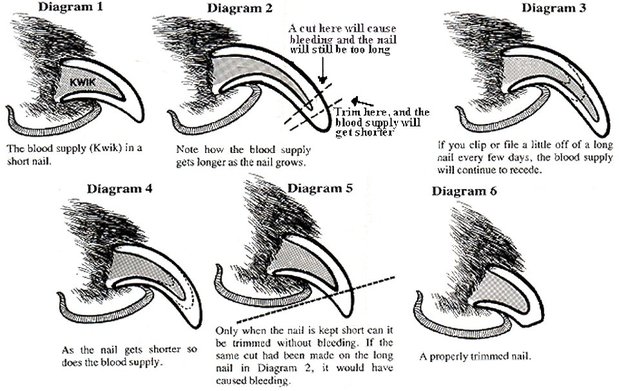
Source & picture from: bunniesathome
Rabbit nails are rounded, so you’ll want a pair of clippers that have a sharp, rounded edge, unlike those for people. Rabbits may have black, clear, or opaque nails (or a mix of all three!), but if you look at the base of the nail you should be able to see a pink or darker shadow (the kwik). If your rabbit has black nails, it will be more difficult to see, but shining a flashlight on the other side of the nail should help. Your aim in trimming the rabbit’s nails is to cut just above the kwik, as in the above diagram, in order to avoid bleeding.
There are many schools of thought on how best to restrain a rabbit while you are trimming the nails, but you’ll need to do some research and figure out what works best and is most comfortable for you and your bunny. I recommend asking someone to help you and to have them hold the rabbit while you cut the nails. Trim the nail at a slight angle facing upward so they aren’t razor sharp but the bun will be able to get a grip on the floor without slipping. If you’re too nervous to trim the nails yourself, some vets will provide the service for a small fee, but again be sure to find a vet who is familiar with rabbits as many are not and consider them exotic animals.
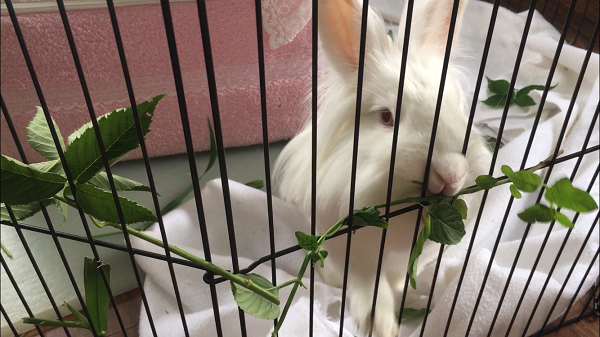 Sometimes Biscotti’s project is eating all the “decorations” in his bakery.
Sometimes Biscotti’s project is eating all the “decorations” in his bakery.
Basic Bunny Care: Fun for Bun
Rabbits love to play and it’s good for them to always have a “project” on hand. Give them objects in their environments that they can move around and manipulate to prevent boredom (and naughty behaviors) and to provide stimulation and exercise. Plain, non-toxic wooden or hard plastic baby toys (NOT “teething” toys) can be appropriate for rabbits, as can little plastic cat toys like jingle balls. Give them a towel or wash cloth you don’t care about and they’ll nip, burrow in, toss, and scoot it around.
Funnily enough, bunnies also love to play with “trash” and will happily dig in and shred a cardboard box filled with junk mail, newspaper, or even an old phone book with the cover torn off (just be sure to monitor the bun to ensure it doesn’t eat too much of whatever paper you give it). Plain brown, corrugated cardboard boxes and empty toilet paper/paper towel rolls are also good for chewing and playing with. You can cut the cardboard into fun shapes for variety and to encourage interest.
Basic Bunny Care: Involving, but Rewarding
It takes time to gain a rabbit’s trust. The amount of information you need to take in can feel overwhelming at first, but although they require lots of work rabbits are very rewarding pets that will love, play and even cuddle with you if you respect and treat them properly.
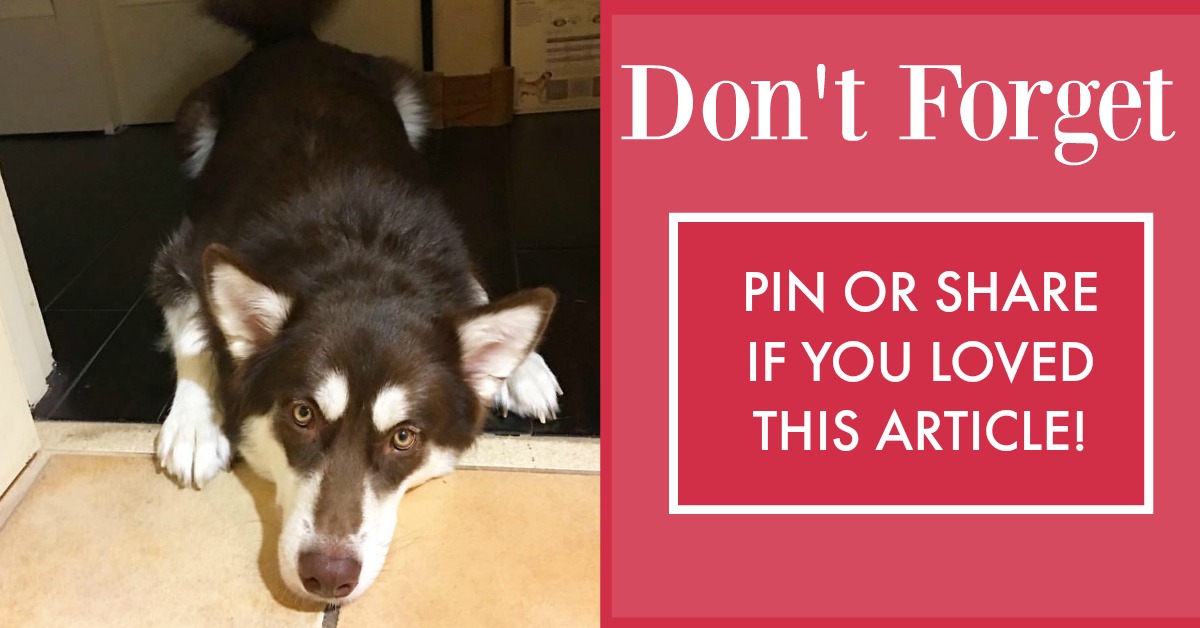
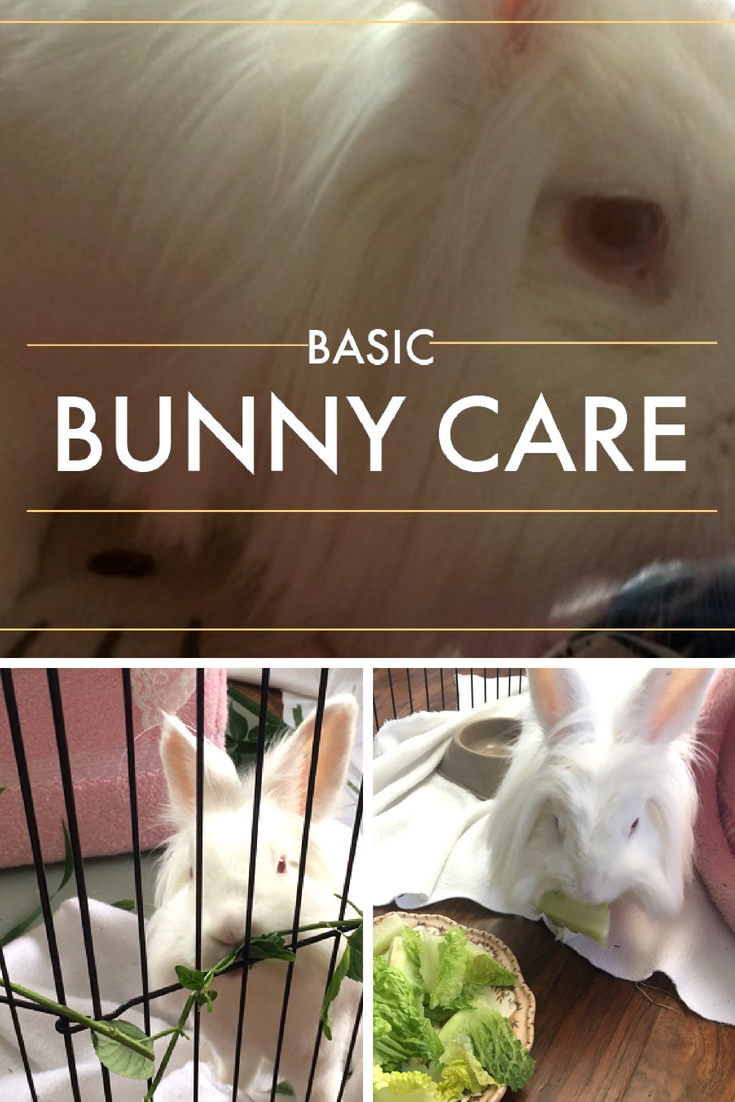

Very interesting, didn’t know the thing about the nails.. It’s a little different from cats.
Very true! Bunnies are pretty unique in their care. I still feel a bit anxious sometimes when I need to trim the nails (I just helped my brother with his rabbit last night; a couple of her nails were getting a bit curly and out of control, yikes!), but both you and the rabbit do get used to it after a while.
I saw your other post saying that bunnies require quite a bit of care. They are so cute, and it does pain me to think how many people get them on a lark, for Easter or spring, and have no clue what a bunny really needs. I used to visit someone who had a bunny, I remember it would hop around the house, adorable! And I see yours likes to be a snuggle bunny, too.
Yes, unfortunately they’re very easy to find in stores and take home and a lot of people don’t think to research their special needs beforehand (although this is true for a lot of animals, from hamsters to sugar gliders). With the right care they’re great pets – Biscotti is a completely different bun from when I first took him home, and you’re right in that he’s a total snuggle bunny! He loves attention and affection even more than he loves snacks. Thanks for reading, Rosie!
This is very good information. I love rabbits! I used to have one and they’re great pets!
Always lovely to meet a fellow rabbit lover! They really are a delight. I had no idea how much of a rabbit person I was until I really researched and took Biscotti in, but now I can’t imagine life without him. Bun = fun.
I never really realized caring for bunnies could be quite complicated. I’m glad you broke it down for us here though. Thank you!
I’ve always wanted a bunny. I don’t think my dogs would take to it though.
This is such a helpful post to me, thank you so much for sharing this! My oldest daughter has been asking for a bunny for a long time now, but I have been hesitant. I had one as a girl, but we lived in the country (in Oregon, where Summers were mild) and had a huge cage for her. Now we live in Texas suburbs and it is good to know that I can keep bun inside.
It sounds like your daughter’s new bun will be going to an amazing home! You’re an A+ mom for wanting to research and be sure you can give bun a happy, healthy environment. Biscotti and I are happy we could help!
It sure seems like there is a lot to consider but it does seem like it can be very rewarding to own a bunny. I never realized how social and bonded they could be as pets.
These are great tips. I wasn’t aware of how to take care of their nails. Your bunnies are so pretty!!!
that is great info, and my daughter wants a bunny, so really good to know in advance
I wish I had this information years ago. When I was young we had two bunnies and I never knew about trimming their nails. This is a very informative post.
Thanks, Deborah! It’s interesting because rabbits are actually a very popular pet and yet the knowledge for their care is not nearly as widespread. Hopefully we can start changing that. 🙂
I’ve never really considered having a pet rabbit, but I recently met one who was so sweet and calm and loves to be held. So maybe….
That’s really funny, Kristen, because the exact same thing happened to me with Biscotti! I wasn’t looking for a rabbit, but then all of a sudden there he was. It took me about a month of deliberating over whether I could give him the home and attention he deserved. I think sometimes we don’t choose our animal friends; sometimes they choose us.